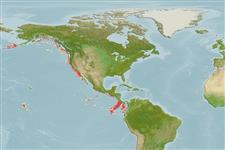>
Perciformes/Zoarcoidei (Eelpouts and pricklebacks) >
Zoarcidae (Eelpouts) > Lycodinae
Etymology: Lycenchelys: Greek, lykos = wolf + Greek, enchelys, -yos = eel (Ref. 45335); callista: Named in reference to the author's perception of the physical appearance of this species compared to its congeners..
Environment: milieu / climate zone / depth range / distribution range
Ecología
marino batidemersal; rango de profundidad 1200 - 1830 m (Ref. 35910). Deep-water
Eastern Pacific: USA.
Tamaño / Peso / Age
Maturity: Lm ? range ? - ? cm
Max length : 20.3 cm TL macho / no sexado; (Ref. 35910)
Short description
Claves de identificación | Morfología | Morfometría
Vértebra: 126 - 136.
Feeds on bivalves, gastropods, and crustaceans.
Life cycle and mating behavior
Maturities | Reproducción | Spawnings | Egg(s) | Fecundities | Larva
Anderson, M.E., 1995. The eelpout genera Lycenchelys Gill and Taranetzella Andriashev (Teleostei: Zoarcidae) in the eastern Pacific, with descriptions of nine new species. Proc. Calif. Acad. Sci. 49(2):55-113. (Ref. 35910)
IUCN Red List Status (Ref. 130435)
Threat to humans
Harmless
Human uses
Herramientas
Special reports
Download XML
Fuentes de Internet
Estimates based on models
Preferred temperature (Ref.
123201): 2.5 - 3.5, mean 2.9 °C (based on 19 cells).
Phylogenetic diversity index (Ref.
82804): PD
50 = 0.5000 [Uniqueness, from 0.5 = low to 2.0 = high].
Bayesian length-weight: a=0.00120 (0.00057 - 0.00252), b=3.10 (2.91 - 3.29), in cm total length, based on LWR estimates for this (Sub)family-body shape (Ref.
93245).
Nivel trófico (Ref.
69278): 3.3 ±0.47 se; based on food items.
Resiliencia (Ref.
120179): Medio, población duplicada en un tiempo mínimo de 1.4-4.4 años (Preliminary K or Fecundity.).
Fishing Vulnerability (Ref.
59153): Low vulnerability (10 of 100).
